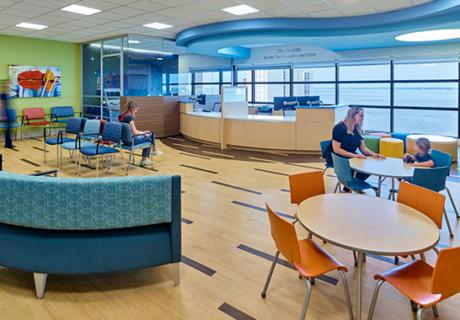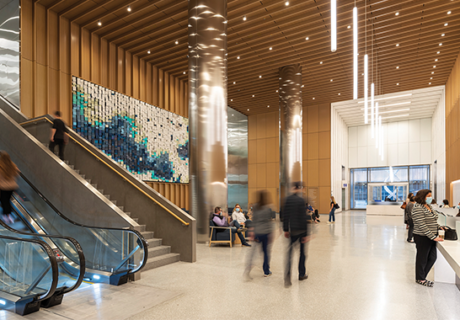Remodel/Renovation Finalist 2017: Mary Bird Perkins Our Lady of the Lake Cancer Center (Cancer Care)
Once separate entities in Baton Rouge, Our Lady of the Lake Regional Medical Center (OLOLRMC) and Mary Bird Perkins Cancer Center (MBPCC) partnered to offer comprehensive cancer care on one campus. In need of a fresh space that embodied this partnership and joint commitment, the firm was engaged to renovate MBPCC-OLOLRMC existing facilities.
A space that provided patients, families and caregivers a sense of ease and assurance during the difficult treatment process was envisioned; one that supported healing with light, texture and comfort, and removed unnecessary stressors for users of the space. The center was to provide a premier patient experience in an uplifting environment that incorporated evidence-based design strategies.
An assessment of existing cancer care services and in-depth analysis that mined for patient experience issues became the basis for thoughtful and deliberate design, ultimately allowing the Cancer Center to provide exceptional, coordinated care.
In our conversations with stakeholders, the team found that existing services were interspersed throughout various buildings on the campus, and that patient navigation and social services played a vital role in cancer care, but that they were not always uniform. In tracing the pathways of patients, it became clear that convenience was not a consistent theme, and that some key services were redundant and disjointed, while others were overburdened. To alleviate these inefficiencies, the firm’s program for the center proposed a centralized place for the co-location of patient services, for ease of access throughout the care continuum.
The firm’s human-centered design respects patient abilities, with a dedicated and convenient entry and discharge process that offers one way flows and decongests the facility. This entry also serves as a “porch” to the OLOLRMC campus at large, acting as a portal to a series of public pathways connecting MBPCC to other key buildings and services, simplifying the patient journey.
The inclusion of hospitality amenities supports respite and refuge, with meditation rooms, private consultation rooms, café area and lounges, and related retail services. Semi-private infusion bays feature personal televisions, space for guests, and reading lights, a direct response to patient requests for an enhanced experience.
The space that the new glass box is constructed within is bound on three sides; by an existing parking garage, the existing cancer center and the hospital, including a bridge structure above at the fifth level. Planning for the structural interventions to remove the existing curtainwall, infill the atrium space to gain additional square footage on the second floor and construct a glass box with new structural columns within this limited space was a challenge. In addition, throughout the six phases of renovations, the cancer center remained operational while increases in volumes continued. The challenges were met with precision-like planning for phased construction and use of pre-fabricated glass and steel systems for the glass box structure which was installed by a specialty contractor on the site to ensure quality and reduced construction time.
Renovation Cost (per square foot): $266










